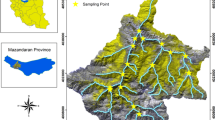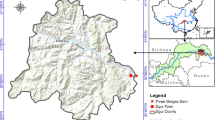Abstract
An accurate understanding of the geomorphic heterogeneity of a river is critical for river management and protection. In this paper, landscape indices, which are widely used in landscape ecology for spatial heterogeneity evaluation, were used to quantify the geomorphic heterogeneity at the reach scale and to identify the important geomorphic features for river management. Eight types of geomorphic patches were extracted from remotely sensed images, and then landscape indices characterizing the geomorphic structure and pattern of a river reach were calculated. Geomorphic structures were determined by measuring the dominance, patch size, and patch shape of geomorphic-patch types. And the geomorphic pattern was measured by using the indices reflecting the spatial configuration of geomorphic patches, hydrological connectivity, and the relative acreage of a geomorphic patch type to the river water surface. Results from the upper and lower Jingjiang reach of middle Yangtze of China showed that these indices can well present the differences in geomorphic structures and patterns within the reach. Based on these quantitative measurements, a set of criteria was established to identify the geomorphic components that are critical, important, or negative for the river-floodplain system. Management strategies targeted to these varied geomorphic components were then formulated and would fundamentally conform to the geomorphic heterogeneity of the river-floodplain system.







Similar content being viewed by others
References
Bathrellos GD, Karymbalis E, Skilodimou HD, Gaki-Papanastassiou K, Baltas EA (2016) Urban flood hazard assessment in the basin of Athens metropolitan city, Greece. Environ Earth Sci 75:319
Brierley G, Fryirs K, Outhet D, Massey C (2002) Application of the river styles framework as a basis for river management in New South Wales, Australia. Appl Geogr 22:91–122
Brierley G, Reid H, Fryirs K, Trahan N (2010) What are we monitoring and why? Using geomorphic principles to frame eco-hydrological assessments of river condition. Sci Total Environ 408:2025–2033
Brierley G, Fryirs K, Cook N, Outhet D, Raine A, Parsons L, Healey M (2011) Geomorphology in action: linking policy with on-the-ground actions through applications of the river styles framework. Appl Geogr 31:1132–1143
Brookes A (1995) Challenges and objectives for geomorphology in UK river management. Earth Surf Proc Land 20:593–610
Charlton R (2007) Fundamentals of fluvial geomorphology. Routledge, Abingdon
DeVries P, Aldrich R (2015) Assessment approach for identifying compatibility of restoration projects with geomorphic and flooding processes in gravel bed rivers. Environ Manag 56:549–568
Dollar ESJ, James CS, Rogers KH, Thoms MC (2007) A framework for interdisciplinary understanding of rivers as ecosystems. Geomorphology 89:147–162
Downs P, Gregory K (2014) River channel management: towards sustainable catchment hydrosystems. Routledge, Abingdon
Forman RT, Godron M (1981) Patches and structural components for a landscape ecology. BioScience 31:733–740
Frissell CA, Liss WJ, Warren CE, Hurley MD (1986) A hierarchical framework for stream habitat classification: viewing streams in a watershed context. Environ Manag 10:199–214
Fryirs KA (2015) Developing and using geomorphic condition assessments for river rehabilitation planning, implementation and monitoring. Wiley Interdiscip Rev Water 2:649–667
Gallardo B, Gascon S, Gonzalez-Sanchis M, Cabezas A, Comín FA (2009) Modelling the response of floodplain aquatic assemblages across the lateral hydrological connectivity gradient. Mar Freshw Res 60:924–935
Garcia XF, Schnauder I, Pusch MT (2012) Complex hydromorphology of meanders can support benthic invertebrate diversity in rivers. Hydrobiologia 685:49–68
Gilvear D, Willby N (2006) Channel dynamics and geomorphic variability as controls on gravel bar vegetation; river Tummel, Scotland. River Res Appl 22:457–474
González E, Sher AA Tabacchi E, Masip A, Poulin M (2015) Restoration of riparian vegetation: a global review of implementation and evaluation approaches in the international, peer-reviewed literature. J Environ Manag 158:85–94
Gorecki VI, Fryirs KA, Brierley GJ (2006) The relationship between geomorphic river structure and coarse particulate organic matter (CPOM) storage along the Kangaroo River, New South Wales, Australia. Aust Geogr 37:285–311
Gostner W, Alp M, Schleiss AJ, Robinson CT (2013) The hydro-morphological index of diversity: a tool for describing habitat heterogeneity in river engineering projects. Hydrobiologia 712:43–60
Gregory KJ, Benito G, Downs PW (2008) Applying fluvial geomorphology to river channel management: background for progress towards a palaeohydrology protocol. Geomorphology 98:153–172
Haase P, Hering D, Jähnig SC, Lorenz AW, Sundermann A (2013) The impact of hydromorphological restoration on river ecological status: a comparison of fish, benthic invertebrates, and macrophytes. Hydrobiologia 704:475–488
Hering D, Aroviita J, Baattrup-Pedersen A, Brabec K, Buijse T, Ecke F, Friberg N, Gielczewski M, Januschke K, Köhler J, Kupilas B, Lorenz AW, Muhar S, Paillex A, Poppe M, Schmidt T, Schmutz S, Vermaat J, Verdonschot PFM, Verdonschot RCM, Wolter C, Kail J (2015) Contrasting the roles of section length and instream habitat enhancement for river restoration success: a field study of 20 European restoration projects. J Appl Ecol 52:1518–1527
Hyodo M, Takemon Y, Sumi T (2014) Spatiotemporal patterns of geomorphological processes determine characteristics of riverine habitat heterogeneity. In: Schleiss et al (eds) River Flow. Taylor & Francis Group, London, 2339–2346
Jansson R, Nilsson C, Malmqvist B (2007) Restoring freshwater ecosystems in riverine landscapes: the roles of connectivity and recovery processes. Freshw Biol 52:589–596
Kokinou E, Skilodimou HD, Bathrellos GD, Antonarakou A, Kamberis E (2015) Morphotectonic analysis, structural evolution/pattern of a contractional ridge: Giouchtas Mt., Central Crete, Greece. J Earth Syst Sci 124:587–602
Kondolf GM, Boulton AJ, O’Daniel S, Poole GC, Rahel FJ, Stanley EH et al (2006) Process-based ecological river restoration: visualizing three-dimensional connectivity and dynamic vectors to recover lost linkages. Ecol Soc 11:5
Lausch A, Blaschke T, Haase D, Herzog F, Syrbe RU, Tischendorf L, Walz U (2015) Understanding and quantifying landscape structure–a review on relevant process characteristics, data models and landscape metrics. Ecol Model 295:31–41
Maret H, Reynard E (2015) Mapping geomorphological diversity. A case study in Derborence (Valais, Swiss alps). In: EGU general assembly conference abstracts 17:4407
McGarigal K, Cushman SA, Ene E (2012) FRAGSTATS v4: Spatial pattern analysis program for categorical and continuous map. http://www.umass.edu/landeco/research/fragstats/fragstats.html
Migiros G, Bathrellos GD, Skilodimou HD, Karamousalis T (2011) Pinios (Peneus) river (Central Greece): hydrological — geomorphological elements and changes during the quaternary. Cent Eur J Geosci 3:215–228
Montgomery DR, Wohl EE (2003) Rivers and riverine landscapes. Dev Quaternary Sci 1:221–246
Palmer MA, Menninger HL, Bernhardt E (2010) River restoration, habitat heterogeneity and biodiversity: a failure of theory or practice? Freshw Biol 55:205–222
Parks KE, Mulligan M (2010) On the relationship between a resource based measure of geodiversity and broad scale biodiversity patterns. Biodivers Conserv 19:2751–2766
Poole GC (2002) Fluvial landscape ecology: addressing uniqueness within the river discontinuum. Freshw Biol 47:641–660
Rappaport DI, Tambosi LR, Metzger JP (2015) A landscape triage approach: combining spatial and temporal dynamics to prioritize restoration and conservation. J Appl Ecol 52:590–601
Reid HE, Gregory CE, Brierley GJ (2008) Measures of physical heterogeneity in appraisal of geomorphic river condition for urban streams: twin streams catchment, Auckland, New Zealand. Phys Geogr 29:247–274
Sear DA (1994) River restoration and geomorphology. Aquat Conserv 4:169–177
Southwood TRE (1977) Habitat, the templet for ecological strategies? J Anim Ecol 46:337–365
Thomas M (2012) A geomorphological approach to geodiversity-its applications to geoconservation and geotourism. Quaest Geogr 31:81–89
Thomson JR, Taylor MP, Fryirs KA, Brierley GJ (2001) A geomorphological framework for river characterization and habitat assessment. Aquat Conserv 11:373–389
Thorp JH, Thoms MC, Delong MD (2010) The riverine ecosystem synthesis: toward conceptual cohesiveness in rive science. Elsevier, New York
Wanner GA, Pegg MA, Schainost S, Klumb RA, Shuman DA (2011) River geomorphology and fish barriers affect on spatial and temporal patterns of fish assemblages in the Niobrara River. Nebraska Game and Parks Commission, Alliance, NE
Ward JV, Malard F, Tockner K (2002) Landscape ecology: a framework for integrating pattern and process in river corridors. Landsc Ecol 17:35–45
Wohl E (2016) Spatial heterogeneity as a component of river geomorphic complexity. Prog Phys Geogr 40:598–615
Xue XH, Yuan LY (2013) Study on the fluvial landscape patterns of upper Jingjiang segment, Yangtze River, using multi-temporal remote-sensing imageries. In: 2013 Fifth International Conference on Measuring Technology and Mechatronics Automation (ICMTMA), IEEE: 1095–1102
Funding
This project is financially supported by National Natural Science Foundation of China (No. 31460132), the S&T Plan Projects of Hubei Provincial Education Department of China (No. B2013277), and the Ph. D research startup foundation of the Hubei University for Nationalities (Grant No. D2014196).
Author information
Authors and Affiliations
Corresponding author
Rights and permissions
About this article
Cite this article
Xue, XH., Chang, S., Yuan, LY. et al. Measuring reach-scale geomorphic heterogeneity by using landscape indices: implications for river management. Arab J Geosci 11, 477 (2018). https://doi.org/10.1007/s12517-018-3843-5
Received:
Accepted:
Published:
DOI: https://doi.org/10.1007/s12517-018-3843-5




